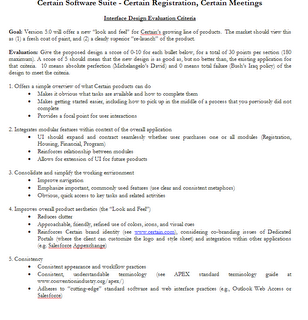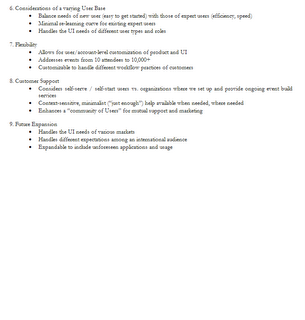Why design matters
Our online registration application is used by over 50 people for their livelihood. Hundreds of our most active users spend a majority of their workday with it. And thousands of event attendees rely on it for about ten minutes a day. The attendees just expect it to work without explanation, and to let them get on with their day. The users need it to boost their efficiency so that they can justify increased pay, decreased hours, and reduced frustration. Our employees need Certain Registration to bring in revenue so that the company can grow with us.
The current application uses a design created in 2001. So the design that we produce over the next 3 months will affect the lives of millions of people for the rest of this decade and beyond. Good design is not easy, and it's definitely not automatic.
Who can do design
You don't have to wear stylish black clothes and square-rimmed glasses to do good software design. You need to know how the users of the application work on a daily basis, what tasks they need to accomplish, and what the application currently lacks. This knowledge is gained through observation, and observation changes with perspective. So I brought together creative minds from all departments: Kathy Isola (Sales), Ryan Manville and Kevin Linder (Development), Jason Whittenberg, Alan Rhody, and Katie Schuler Herstein (Product Design), Cole Blevins and Bob Osborn (Client Services), Paul Bosky (Training), Dana Chrisler (Marketing), Doug Goldman (Founder), and Bruce Browne (External Design Expert).
How to do design
We used Bruce Browne’s design methodology from his Quicken days with Intuit:
- Define goals and objectives
- Research and Review: Evaluate existing interface. Identify key problem areas. Map current application organization. Review groupings of tasks/features.
- Brainstorm new designs: Break into groups of 1-2 people to produce design alternatives, with each group focused on one Use Case.
- Review: Present designs to larger group for evaluation using objective criteria, and select design metaphors for further refinement and evaluation
Outcome
Over the next several weeks, we will continue to refine our design and post new mockups and wireframes in an internal Wiki for review and comment. Then, we will open the best designs to our community of expert Users, for their comment and further refinement. I'll continue to update you on our progress as we go.



No comments:
Post a Comment